Video
youtube
Experience how a VR is without the VR headset. This virtual reality game footage exactly shows you how it is to be wearing the headset.
0 notes
Link
Star-trek ways of communications going to be real soon..!!
1 note
·
View note
Video
vimeo
Oblong’s g-speak
http://www.oblong.com/g-speak/
0 notes
Text
Virtual Visits
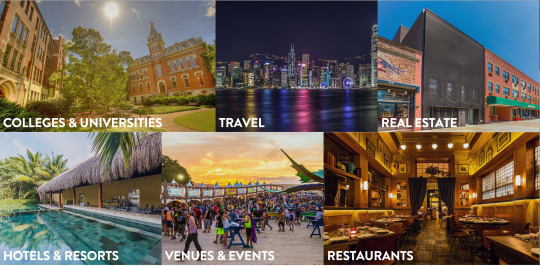
Virtual reality seeping into every domain known. My design proposal is in line with virtual visits.
http://www.youvisit.com/
0 notes
Link
Discovering places through VR is not a new trend. How about rebuilding the past as part of the VR?
0 notes
Text
HUB studio
The HUB studio was indeed a hub bubbling with latest interactive technologies and developments. We were introduced to 3D modeling softwares and sound design techniques, which were used in conjunction for a VR experience with an Oculus rift.





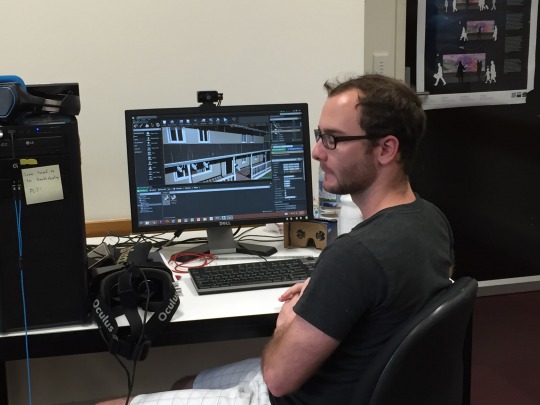






Wesley Heard is a Honors student and the lab’s VR artist. His project is building a proof of concept (POC) by means of a game inside a 3D built house. He showed us the process of building a 3D object in 3D max and then exporting it to the Unreal game engine to activate the VR environment. He is also looking into incorporating the peripheral vision in VR for enhanced effects.
Nathan Corporal, also a Honors student is the lab’s Sound designer. He is working on creating 3D audio by recording natural sounds using a very sensitive dictaphone called Zoom H4N recorder and then works on a Digital Audio Workstation (DAW) and Reaper to edit it. Further behavioral cues like distance are added to the audio using the FMOD software. This 3D sound works well in a VR environment by allowing the user to ‘feel’ the sound as it travels around.
We then experienced the world of virtual reality through Oculus rift DK2. Works such as Nighttime Terror by Mark Schramm, Dread Halls by Sergio Hidalgo and Colosse were few among the others we witnessed. HUB lab focuses on researching, exploring and applying the technology in Virtual Reality.
0 notes
Link




Laser scanners are used more than you can ever imagine
1 note
·
View note
Link
Gesture tracking thumb ring

Empowering the physically challenged as well..!
0 notes
Text
Viser Lab
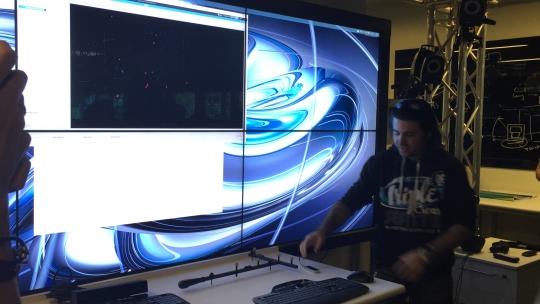






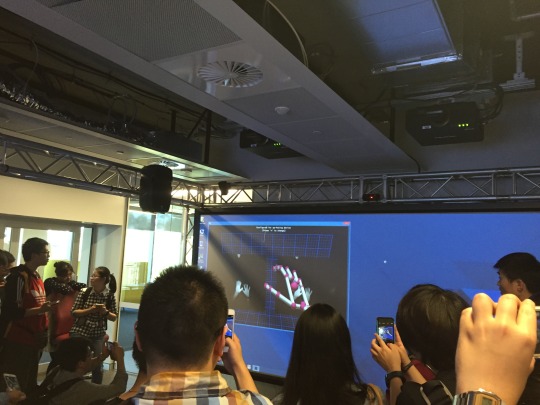


Viser Lab visit.
We were introduced to gesture and foot tracking technologies such as the g-speak, leap motion and SICK laser scanners.
0 notes
Text
Design Proposal
BRIEF
This design proposal aims to recreate historical places and events uses virtual reality and immerse the user using gesture tracking.
BACKGROUND
We live in a multi-cultural society. In order to understand and respect each other’s cultures and values, knowing their cultural or religious history becomes necessary. Gaining knowledge of these is a tedious process as it involves a lot of reading and researching. Converting this whole process into virtual reality, we can make it a fun and valuable exploring experience.
DESIGN CONCEPT
This design proposal, which is a design intervention, uses virtual reality to build historical places in texts that has been ruined or does not exist anymore. This idea uses the VR and gesture tracking technologies. The main purpose is to enhance a reading experience and help the user experience the story. Virtual reality technology can give the users an immersion experience, as users head movements are tracked in a three dimensional space, and it also adds a behavioral sound to make users feel virtual reality world's feeling (Paul. 2015).
To explain the concept in more detail, I would like to consider an example, a religious text with historical events, such as “The Holy Bible”.
There are two dimensions to it—
A Virtual Reality app that can be accessed from home.
The end product is envisioned as an app. The user has to use a VR headset and a gesture tracking device such as the ‘Leap motion’ or a G-speak glove. The user can select a location on the biblical map to witness the events that occurred there. One can also select to go through the entire bible in any order namely, chronological or canonical (as printed in the bible). Using gesture technology they can choose, zoom and travel in the location. The user can choose to dive-in more into that topic by reading the relevant text overlayed on the virtual screen or move to another location. Users can witness the historical events such as splitting of the red sea, Noah’s ark or the Last Supper.
An Augmented Reality experience that can be initiated at the historical site.
On visits to historical sites such as Jerusalem, the user can use the AR app or an AR headset with the phone inside it, which will then activate the display of corresponding displays pertaining to that location. For example, at a ruin site, the user can see the ancient building in it’s full glory and realize the importance to that place. The user can take off the headset and see the present condition and understand how it has changed. This application can be a tourist guide with audio guidance as the user turns around. The user can set the language and speed of the display. This will give the user an immersive experience to the visit.
TARGET AUDIENCE
It would be of great help for people who are involved in studying the past, history, religion or even a culture. This can be extended beyond the idea of religious or cultural texts to story books, recreating war scenes and educational purposes. Students can learn, for example, the molecular structure of chemicals. They can interact with the molecules and experience how a chemical reaction works. People can see what happened in a war and thus can realize a soldiers sacrifice more intensely. Knowing past incidents, and occurrences helps develop a deeper sense of understanding and thus strengthens the the bond between people of various cultures.
THE POTENTIAL IMPACT ON THE LAB AND STAKEHOLDERS
By combining VR, gesture tracking and 3d audio technologies, both the labs (VISER lab and the HUB studio) can take a step ahead in bringing out a immersive interactive experience to the user.
Implementing this proposal requires a lot of people to work in content creation, 3D modeling, and sound engineering. Thus, it would result in more job opportunities.
Any country’s government could implement this proposal to attract more tourists and thus build on revenue generation.
Common man will be more inspired to learn about others cultures or history.
People who are keen to learn something but dislike reading books can quickly adapt to this technology and learn easily.
Students and teachers could benefit a lot in classroom environment and otherwise.
Knowing the history of a place helps in preserving it’s historical remains more efficiently with value and it can be passed on to future generations.
One of the best learning methods as visual memory tends to remain in the mind of a person than a read passage.
DESIGN VISUALISATIONS
Below is a storyboard as visualized in the example scenario.

0 notes
Photo

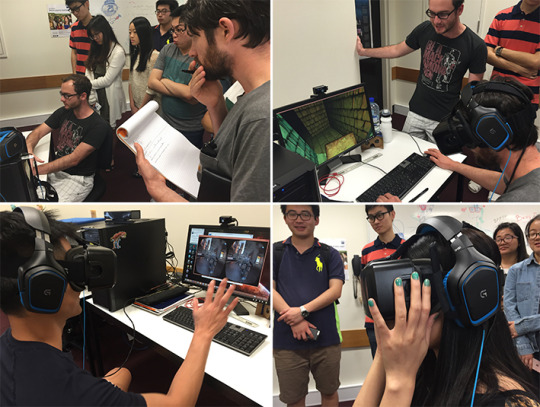


Lab Visit 05: Virtual Reality Part 2.
Today we visited HUB Studio to experience Oculus Rift VR Worlds for the first time.
Hub Studios VR Artist and Honours student, Wesley Heard, started off by showing us all how he constructs 3D assets in 3D Max and then introduced us to the Unreal Engine interface.
Then the HUB Studio Sound Designer and Honours student, Nathan Corporal, introduced us to recording and editing (Reaper) sound for 3D Audio integration in VR (FMOD).
We then got to try out the Unreal Engine 4 demo, Showdown and other works such as Colosse, Dread Halls by Sergio Hidalgo and Nighttime Terror by Mark Schramm... and others. Such fun!
This was our last Masters session for this special unit. The Lab Visits were a wonderful experience and I can only hope that the students were inspired by the access so many wonderful people gave us to their studios, technologies, projects, designers, developers and researchers.
And a massive thanks to all of the students of the MCI IVD program at QUT. I learned a great deal from you all and very was reinvigorated as a lecturer by your energy, enthusiasm, thoughtfulness and creativity throughout the semester.
11 notes
·
View notes
Photo

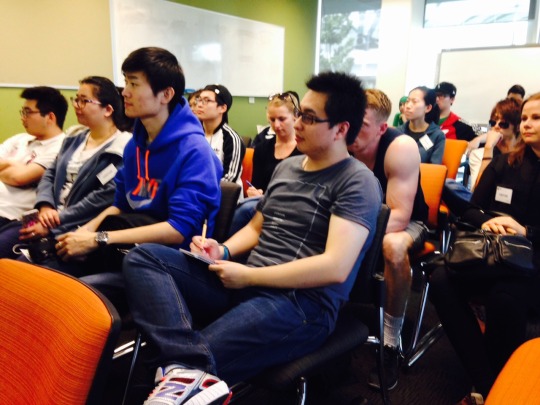




Lab Visit 03: Biofabrication Lab at QUT
Associate Professor Mia Woodruff, Sean Powell, Naomi Paxton and other researchers greeted us at the QUT Institute of health and Biomedical Innovation and began the special session with a presentation outlining the background research, collaborators and the processes and techniques involved in the 3D printing of body parts. Then smaller groups took turns in visiting the Biofabrication Lab to see the printers and sample printed materials… and see a demonstration of the various software applications used in the Lab.
As interaction designers, some stand-out topics:
3D Scanning, Processing and Visualisation
Testing processes and requirements
Laboratory users and how they interface with data, technology and each other
3D data <> 3D Printing - controlling calibration and accuracy
3D modelling, animating and customisation
Patient experience - and how patients interface with the researchers, medical experts and laboratory processes
Tools (applications/devices) and control interfaces (input and output)
Communication systems - researchers, patients, government, organizations and the public
Design Process, Analysis and Intervention - before, during and after Printing occurs?
Can you think of any others?
More information on the QUT Biofabrication Lab, their researchers and the very important work that they all do.
https://youtu.be/4PV6WZywE-4
https://youtu.be/71y-Pw9XYbw
http://theconversation.com/from-science-fiction-to-reality-the-dawn-of-the-biofabricator-45309
http://www.nature.com/news/the-printed-organs-coming-to-a-body-near-you-1.17320
And the broader community: https://twitter.com/hashtag/biofabrication
9 notes
·
View notes

